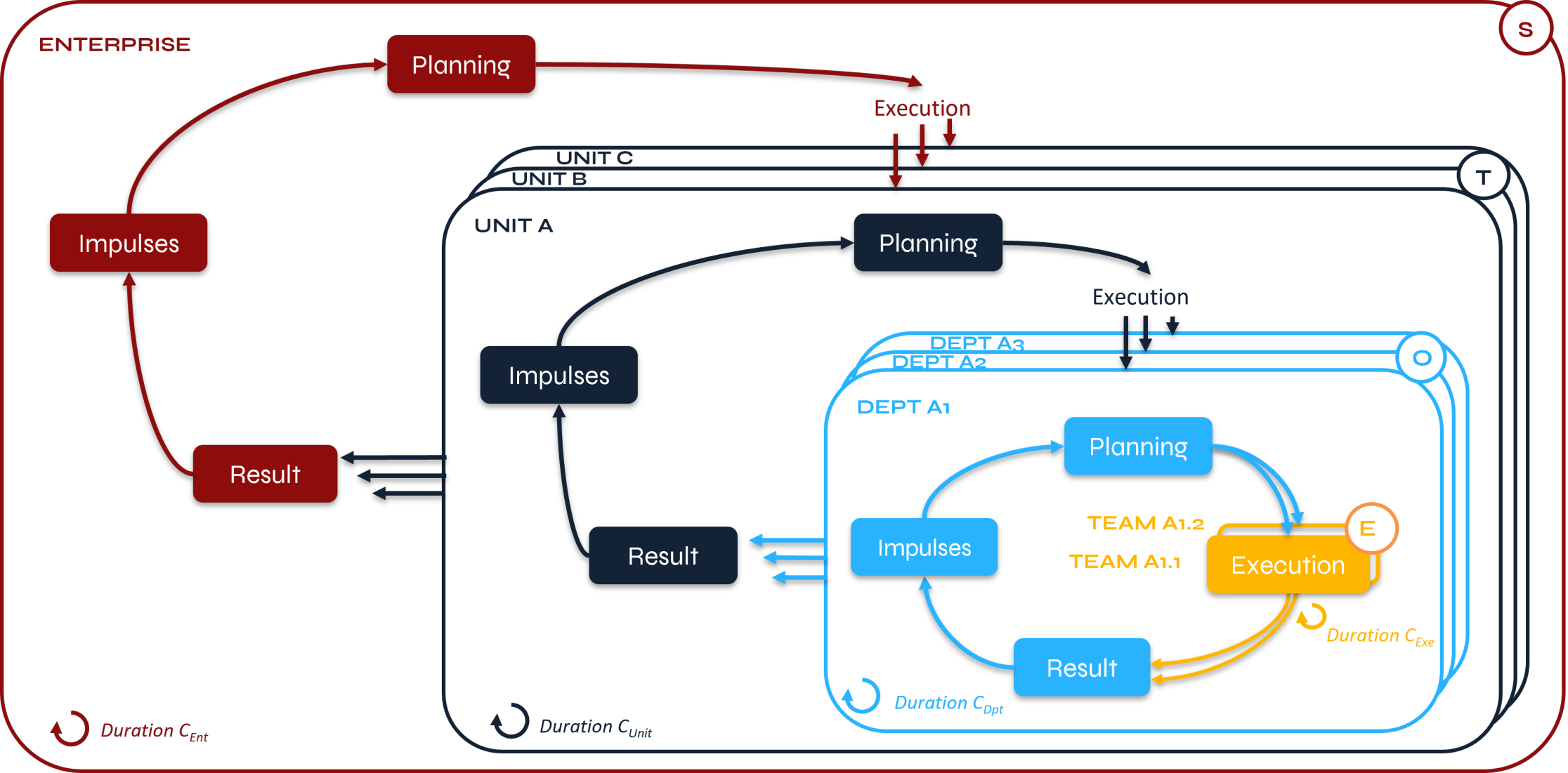Managing Organizations in the Age of Value – part 3
Frederic Dufour / Aug 17 , 2023Introduction: Navigating the Intricacies of Value Fractals
In today’s complex and ever-changing business environment, the simplicity of linear models such as the value chain is being challenged by a more realistic conceptualization of organizational complexity: the value fractal. In this article, we will analyze this fractal nature of an organization, while highlighting the central role of the manager as the orchestrator of its functioning.
Understanding Value Fractals
A value fractal is a representation of the recursive nature of the management process that exists at every level of an organization, akin to how a fractal in mathematics consists of self-repeating structures at every scale.
Here’s a breakdown:
Foundation of value fractals
Value fractals derive from the concept that organizations, regardless of their size or sector of activity, can divide their processes into smaller units, each echoing overarching objectives focused on value creation. Each of these units, although autonomous, is interconnected and contributes to the overall success of the organization.
Self-similarity and adaptability
Value fractals embody the principle of self-similarity, meaning that the organization’s overall objectives are reflected in each smaller unit. However, this does not mean that they are rigid. Each fractal adapts to its own context, ensuring flexibility and responsiveness to local challenges and opportunities.
Fostering recursive harmony
Given the recursive and multi-level nature of the value fractal, a key component is its ability to encapsulate both the macro and micro perspectives of management. Managers, while orchestrating their designated management cycles, also simultaneously become cogs in a broader cycle, ensuring a harmonious and synergistic flow of value creation through various management levels.
Navigating through the management cycle
Each management level within an organization is driven by a four-phase management cycle:
- Impulses: deriving and formulating intention from internal and external data inputs, shaping the seed of action.
- Planning: evaluating scenarios, resources, and priorities, culminating in decisive action plans.
- Execution: operationalizing plans, where a subordinate management cycle commences, embodying its own impulse to result trajectory.
- Result: assimilating outcomes, which not only conclude the present cycle but also become an impulse for subsequent ones.
The following diagram illustrates the deployment of a value fractal in an organization composed of four management levels.

Applying the Value Fractal across Varied Organizational Scales
Universal applicability
From dynamic start-ups to multinationals, the value fractal applies to every situation. While depth and complexity may vary, the fundamental principle of recursive management cycles remains a constant. The universality of the value fractal offers a framework that could potentially align diverse and complex organizational structures to a unified management rhythm.
Agility amidst complexity
The value fractal, by its dynamic and temporal nature, offers organizations the opportunity to maintain operational agility despite their complexity and intricacy. By modulating the frequency and nature of management cycles at different levels, organizations can potentially achieve a level of responsiveness and adaptability that belies their structural complexity.
Bridging value indicators with value fractals
The value fractal offers the ideal structure for integrating value indicators at all levels of the organization. Just as a fractal in nature constantly reproduces its pattern whatever the scale, value indicators, when introduced into a value fractal framework, become inherent in every operational process, every decision and every strategic initiative. In so doing, the organization ensures that the principles of societal value, environmental stewardship and overall stakeholder satisfaction are not just fine ideals, but concrete realities reflected throughout the entire organization.
Value Fractal vs. Value Chain
The value chain, introduced by Michael Porter in 1985, has reshaped the way we perceive organizational activities and their contributions to an organization’s value creation. However, the static, linear and financial approach of the value chain no longer meets the needs of modern organizations, which must be agile and resilient in the face of the speed of change in today’s world.
Key differentiators
- Complexity and repetition: unlike the value chain’s linear progression, a value fractal encapsulates repetitive patterns across different scales and levels of the organization, reflecting the multifaceted nature of modern business operations.
- Adaptability and resilience: value chains, being linear, can often be rigid. In contrast, fractals are inherently adaptable. Their repetitive patterns mean that disruptions at one level might not necessarily disrupt another, offering a buffer against shocks. This makes value fractals more resilient than value chains.
- Holistic perspective: the value fractal offers a more comprehensive view, accounting for inter-departmental and inter-organizational connections, capturing the broader essence of organizational dynamics.
- Stakeholder engagement: the value fractal encourages and even relies on the active participation of stakeholders, ensuring that their views influence value creation at all levels, whereas a value chain tends to instrumentalize stakeholders, potentially sidelining their ideas or aspirations.

The role of the Manager in the Value Fractal
In this intricate web of connections, the manager’s role extends beyond mere oversight. They play the part of an orchestrator, ensuring a harmonious flow within the fractal, addressing any external impulses, and maintaining internal coherence.
Balancing external impulses and deterministic rules
The first characteristic of a manager in the value fractal environment is their nuanced ability to strike a balance. External impulses, whether market shocks, regulatory changes or sudden innovations, constantly shake the organization. The manager’s delicate task is therefore to strike a balance between absorbing chaotic events and respecting deterministic rules that ensure that fundamental processes retain their integrity and quality.
Tools: planning, simulation, and decision intelligence
In the digital age, managers are armed with a range of tools that enhance their orchestration capabilities. Advanced planning systems enable detailed mapping of fractal patterns, revealing vulnerabilities and opportunities. Simulation tools allow managers to anticipate the cascading effects of a decision, enabling them to develop strategies in anticipation of different types of event. It’s less a question of predicting the future than of preparing for multiple eventualities.
Processes: building redundancy and flexibility
Resilience in a value fractal doesn’t just happen. It is designed through processes that are both robust and adaptable. Feedback loops ensure that the organization is always on the road to improvement. Common rules and frames of reference establish a shared understanding, fostering collaboration within the fractal. The network structure, with its inherent redundancies, ensures that even if one node is disrupted, the system as a whole remains operational.
Mentality: cultivating the entrepreneurial spirit
The real leap from the traditional value chain to the value fractal lies in the change of mindset. Managers become catalysts of entrepreneurial energy. By granting organizational entities the autonomy to operate, decide and innovate, they unleash a whirlwind of creativity and adaptability. This is not about giving up control. It’s about recognizing that in a complex, interconnected world, agility and autonomy often prevail over hierarchy.
Why Value Fractals are the Future
- Robustness in the face of disruption: the interconnected nature of value fractals means they can better handle external shocks. If one part faces disruption, other parts can adapt and continue, making the organization as a whole more resilient.
- Fluidity in response: value fractals allow for a more fluid response to challenges and opportunities. Instead of a rigid sequence, organizations can pivot and adapt quickly.
- Reflects modern business reality: today’s businesses aren’t isolated entities but are part of a vast web of interconnections, from supply chains to partnerships. The value fractal, with its emphasis on repetition and connection, better represents this reality.
- Strategic management: in the fractal setting, management isn’t about overseeing a linear process but understanding and influencing a dynamic web. It involves a mix of foresight, adaptability, and the ability to maintain balance.
Concluding Reflections on the Fractal Paradigm
The metamorphosis from linear value chains to intricate value fractals signifies a monumental shift in business management and operational architecture. Navigating through the complex, dynamic landscapes of modern enterprises, the value fractal paradigm champions adaptability, resilience, and intricate connection, accurately mirroring today’s multifaceted business ecosystems. Managers, redefined as dexterous orchestrators, must harness these multidimensional structures, fostering an environment where entrepreneurial spirit, strategic foresight, and an embrace of interconnected processes pave the way for sustainable success. In this era of continual disruption and technological advancements, value fractals don’t merely represent a new methodology; they signify the future of intelligent, resilient, and thriving value organizations.
Print
Download
More ARTICLES
You may also like
Managing Organizations in the Age of Value – part 2
In this part 2, discover how organizations implement value indicators to contributing positively to global issues, countering greenwashing.
Managing Organizations in the Age of Value – part 1
In the present article, we focus on the concept of value organization and value manager, and their implications in the evolving organizational ecosystem.
Decide, Execute, and Monitor Faster and Smarter – part 2
In recent years, industries around the world have been faced with an unprecedented challenge: the dwindling number of qualified candidates. How to cope with it?







